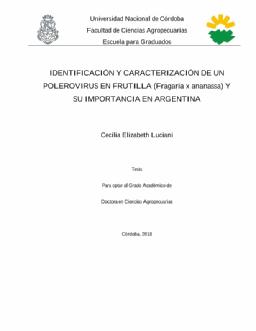| dc.contributor.advisor | Conci, Vilma C. | |
| dc.contributor.advisor | Celli, Marcos G. | |
| dc.contributor.author | Luciani, Cecilia Elizabeth | |
| dc.date.accessioned | 2018-08-08T19:44:44Z | |
| dc.date.available | 2018-08-08T19:44:44Z | |
| dc.date.issued | 2018 | |
| dc.identifier.uri | http://hdl.handle.net/11086/6498 | |
| dc.description | Tesis (Doctor en Ciencias Agropecuarias) -- UNC- Facultad de Ciencias Agropecuarias, 2018 | es |
| dc.description.abstract | Los virus en frutilla son responsables de importantes pérdidas del rendimiento y calidad de los
frutos. En Argentina se ha detectado la presencia de Strawberry mild yellow edge virus
(SMYEV), Strawberry mottle virus (SMoV) y Strawberry crinkle virus (SCV). Entre 2015 y
2016 en los laboratorios del IPAVE-INTA se obtuvieron fragmentos genómicos
correspondientes a un polerovirus infectando frutilla. Simultáneamente se reportó en Canadá a
Strawberry polerovirus 1 (SPV1). El objetivo de esta tesis fue identificar y caracterizar
específica e intraespecíficamente el nuevo virus detectado en el país, y evaluar aspectos
epidemiológicos que permitan dilucidar la importancia del patógeno. Los objetivos específicos
fueron: 1) Identificar y caracterizar el posible polerovirus detectado en frutilla de Argentina. 2)
Implementar un sistema de diagnóstico capaz de detectar el virus en cultivo. 3) Obtener la
secuencia genómica completa de virus. 4) Detectar y analizar la variabilidad específica e
intraespecífica del polerovirus y su filogenia. 5) Implementar un sistema de diagnóstico
sensible que permita el análisis simultáneo de los virus. 6) Evaluar aspectos epidemiológicos
que contribuyan a determinar la importancia y distribución del SPV1 en zonas productoras de
frutilla en relación a otros virus presentes. Los resultados confirmaron la presencia de SPV1
en Argentina, se implementó un sistema para su detección y se transmitió a plantas de
Fragaria vesca var. Semperflorens “Alpina”. Se obtuvo el 99,5% de la secuencia genómica
del virus y su análisis filogenético permitió detectar que SPV1 forma un cluster diferente en el
género Polerovirus. Se obtuvieron 8 secuencias del gen de la cubierta proteica del virus y se
detectaron diferencias genómicas entre los aislamientos reportados, relacionadas con el origen
de plantas madres. Se determinó la incidencia y prevalencia del SPV1 en las principales
regiones productoras del país y su relación con los parámetros climáticos, regiones, cultivares,
síntomas y su relación con SMYEV, SMoV y SCV, para los cuales se implementó un RT-PCR
Multiplex para su detección. El SPV1 fue el tercer virus más frecuente de frutilla en Argentina
y se relacionó de manera positiva con la región de Coronda y las precipitaciones. | es |
| dc.description.abstract | Strawberry viruses are responsible for significant yield and fruit quality losses. Strawberry
mild yellow edge virus (SMYEV), Strawberry mottle virus (SMoV) and Strawberry crinkle
virus (SCV) have been detected in Argentina. Genomic fragments belonging to a polerovirus
infecting strawberry were obtained at IPAVE-INTA between 2015 and 2016. Simultaneously,
Strawberry polerovirus 1 (SPV1) was reported in Canada. The objective of this thesis was to
identify and characterize, the new virus detected in the country at the species and intraspecies
levels, and to evaluate epidemiological aspects that determine the importance of the pathogen.
The specific objectives were to: 1) identify and characterize the possible polerovirus detected
in strawberry from Argentina; 2) implement a diagnostic system capable of detecting the virus
in the crop; 3) obtain the complete genomic sequence of the virus; 4) detect and analyze the
specific and intraspecific variability of the polerovirus and its phylogeny; 5) implement a
sensitive diagnostic system that allows the simultaneous analysis of viruses; 6) evaluate
epidemiological aspects that contribute to the determination of the importance and distribution
of SPV1 in strawberry-producing areas in relation to other viruses present. The results
confirmed the presence of SPV1 in Argentina; a system was implemented for its detection and
it was transmitted to plants of Fragaria vesca var. Semperflorens "Alpina". Most (99.5%) of
the genomic sequence of the virus was obtained and its phylogenetic analysis showed that
SPV1 forms a different cluster in the genus Polerovirus. Eight sequences of the virus protein
coat were obtained and the reported isolates showed genomic differences, related to mother
plant origins. The incidence and prevalence of SPV1 was determined in the main producing
regions of the country and its relationship with the climatic parameters, regions, cultivars, and
symptoms as well as with SMYEV, SMoV and SCV, for which a Multiplex RT-PCR was
implemented for their detection. SPV1 was the third most common strawberry virus in
Argentina and was positively related to the Coronda region and precipitations. | en |
| dc.format.extent | 80 h. : fotografías color, gráficos, tablas | es |
| dc.language.iso | spa | es |
| dc.rights | Attribution-NonCommercial-NoDerivatives 4.0 Internacional | * |
| dc.rights.uri | http://creativecommons.org/licenses/by-nc-nd/4.0/ | * |
| dc.subject | Frutilla | es |
| dc.subject | Fresa | es |
| dc.subject | Virosis | es |
| dc.subject | Virus | es |
| dc.subject | Identificación | es |
| dc.subject | Secuencia nucleotídica | es |
| dc.subject | Variación genética | es |
| dc.subject | Filogenia | es |
| dc.subject | Diagnóstico | es |
| dc.subject | Epidemiología | es |
| dc.subject | Argentina | es |
| dc.title | Identificación y caracterización de un polerovirus en frutilla (Fragaria x ananassa) y su importancia en Argentina | es |
| dc.type | doctoralThesis | es |





